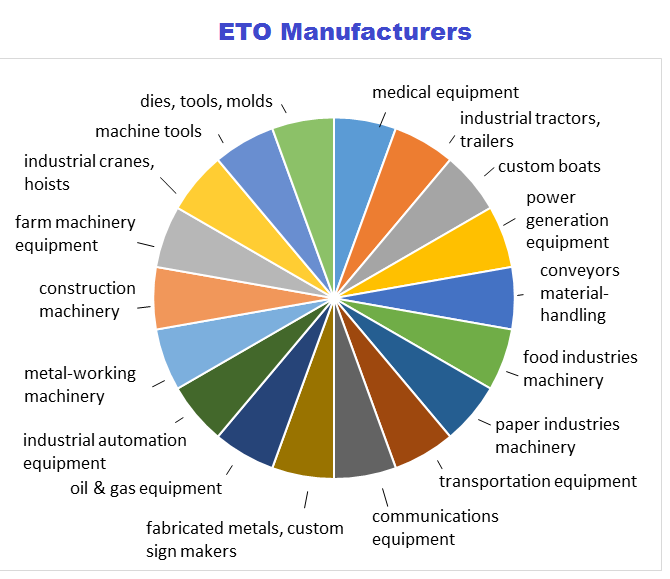 Process manufacturing is different, distinct, and distinguishable from discrete manufacturing. Process manufacturing uses formulations versus discrete manufacturers use Bills of Materials (BOMs) and assembles along a routing. Process manufacturers blend a batch – often a literal recipe found in food and beverage manufacturing.
Process manufacturing is different, distinct, and distinguishable from discrete manufacturing. Process manufacturing uses formulations versus discrete manufacturers use Bills of Materials (BOMs) and assembles along a routing. Process manufacturers blend a batch – often a literal recipe found in food and beverage manufacturing.
Discrete manufacturers are typically ETO (engineer-to-order), which includes make-to-stock (MTS), make-to-order (MTO), and assemble-to-order (ATO) production facilities. Because each product manufacturer is unique, often requiring on-going modifications and engineering during the manufacturing process, there is a strong requirement for synchronized planning, scheduling, execution management and tracking capabilities. Without this alignment and monitoring, operations may degrade and erode profitability.
Assembly is the cornerstone of discrete manufacturing; it is an exact and precision-focused process. Products are most commonly manufactured in individual production sequence and size, scope, and materials vary widely. In discrete manufacturing production, orders and products change frequently from order to order.
Process manufacturers build something that cannot be taken apart; once the cake batter ingredients have been mixed, the ingredients cannot be removed from the finished goods produced. This makes process manufacturers formula-focused.
 Discrete manufacturers make finished goods that have components that can be taken apart and used in another capacity. Discrete manufacturing can be reversed, while process manufacturing is irreversible.
Discrete manufacturers make finished goods that have components that can be taken apart and used in another capacity. Discrete manufacturing can be reversed, while process manufacturing is irreversible.
Discrete manufacturing uses complex, layered BOMs while process manufacturing uses multiple recipes and formulas. Process manufacturing looks at shelf life and lot potency. Shelf Life is defined by the Department of Defense (DoD) Shelf Life Management Manual:
“The total period of time beginning with the date of manufacture, date of cure (for elastomeric and rubber products only), date of assembly, or date of pack (subsistence only), and terminated by the date by which an item must be used (expiration date) or subjected to inspection, test, restoration, or disposal action; or after inspection/laboratory test/restorative action that an item may remain in the combined wholesale (including manufacture’s) and retail storage systems and still be suitable for issue or use by the end user.”
Discrete manufacturing values serial numbers, assembles, and ECNs. An engineering change notice (ECN), or change notice, is a document which records or authorizes a change to a specific design. Following sound engineering principles, control and documentation are necessary to ensure that changes are built upon a known foundation and approved by relevant authorities.
An ECN must contain identification of what needs to be changed. This should include the part number and name of the component and reference the drawings that show the component in detail or assembly.
It must also include the reason(s) for the change as well as a description of the change. This includes a drawing of the component before and after the change. Generally, these drawings only reflect the detail affected by the change.
ECN’s unique to discrete manufacturers list documents and departments affected by the change. The most important part of making a change is ensuring that all pertinent groups are notified and all documents updated.
Process manufacturing has the production characteristic which includes few or minimal interruptions in processing within one production run, or between production runs of similar products.
Discrete engineered-to-order manufacturing includes a high level of customer participation in the design and manufacturing process of the product. Multiple stakeholders and participants work together to make a complex product. Commonly there are challenges, difficulties, and changes as the product is being manufactured. A troublesome problem in the design phase, often translates to a damaging setback in the manufacturing phase.
Engineered-to-order mandates that production information and specifications are constantly moving between the ETO company and the customer. Product data including design specifications, requirement files, and engineering changes are as fast as a great racquetball game. Confusion ensues without a clear, concise exchange of product information. The result of failing communication in the ETO discrete space is the thin margin between a profitable or unprofitable project.
Process industries make products in bulk quantities, such as pharmaceuticals, food and beverage, and paints. Discrete manufacturers produce or assemble component or finished products recognized by serial numbers or labeling products and assessable as numerical quantities rather than by weight or volume.
Do you have any other distinctions you think we should add? If so, drop us a comment!

